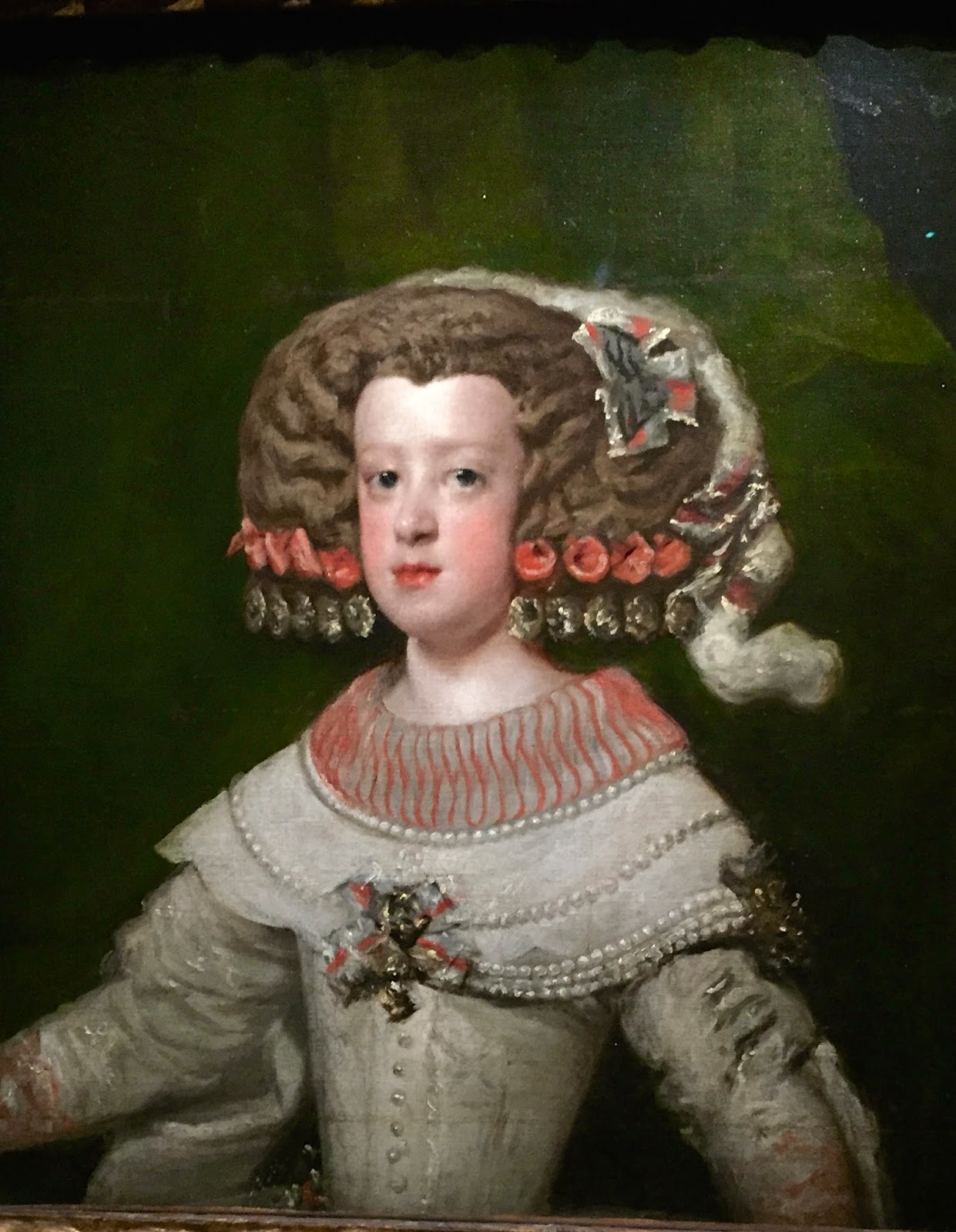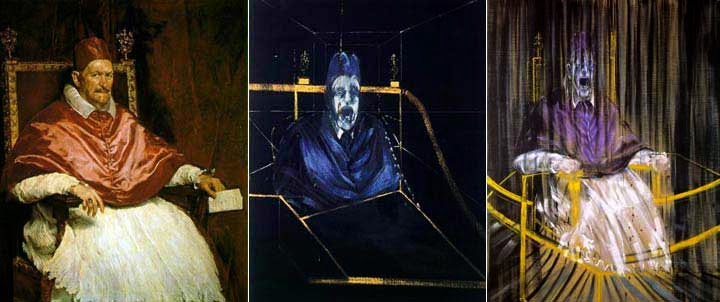A STRANGE WAY TO DISCOVER AN ARTIST........
Does it seem strange to you that I discovered Velazquez through Francis Bacon?
The Velazquez 1650 portrait of Pope Innocent X. Although Bacon avoided seeing the original, it remains the single most influential painting on him, and its presence can be seen in many of his best works from the late 1940s to the early 1960s.
Mother and I had gone to the Beyler Foundation for the first time in 2004. A close friend had spoken to us about Francis Bacon and with a click of the computer we were on the train to Basel. Bacon was one of the most significant objective painters of the twentieth century and very soon became a favorite painter.
The exhibition comprised about forty works by Bacon, and about the same number by artists, including Titian, Velazquez, Rembrandt, Ingres, Degas, Picasso and Alberto Giacometti,
………
This was our first trip away for an Exhibition in another country. I can assure you, we were both bowled over. Not by the great Masters, no, but by Francis Bacon. This exhibition was to be the beginning of many with many discoveries for us both.
As the years went by, I learned much more about Velazquez. I saw his work in the Prado, in Seville where he was born in 1599 and there were of course paintings of his in the major museums around the world. So now I was about to discover the first major retrospective of his works with over 170 paintings.....
This was, once again, a block buster. I was lucky to have been permitted to get in when I did as many people were leaving and the new crowd had not yet climbed the stairs.
From the start, you feel that Velazquez was a very ambitious artist. His portraits are so big that without having the space to look at them, I found many overpowering. His main ambition was to become the King’s painter which he did in 1623 after a few attempts beforehand.
It was then that he painted the King’s portrait which was appreciated and a little later he was appointed the King’s painter. Philip lV. When the heir was born, Baltasar Carlos, Velazquez was still in Italy. Upon his return, the painter had to devote himself as a priority to portraits of the heir. Paintings show clearly how the young prince grows up. There are many of them. This is just a small selection
Came later a series of princess which left me quite confused - and as I was then told that photography was not permitted - I just went from painting to another. Hair, dresses, faces looked the same to me. It may well have been fashion but there didn’t seem to be any real identity.I might add that the hairstyles were wigs and decorated very lavishly as you can see.
I imagine that all these young princess make you think that perhaps we saw Las Meninas ?
Like so many of the great paintings today, it never leaves the wall in the Prado!
What I did like were some of his more down to earth scenes. Taverns, just ordinary people with a little mythology thrown in.
Of course seeing the the portrait of Innocent X brought back memories. This time though, I didn’t have Francis Bacon to distract me.
I’m going to see « The Tudors » later in the week. This will hopefully bring back some knowledge of my history lessons in Tasmania….well, miracles can happen.
However, I was bemused. Why hadn't I come accross The American Icons? What I had really come to see. To be perfectly honest I was feeling rather limp after two hours of exhibitions, so would catch the bus and go home - but then, I saw the entry to what I had been looking for .....well I could just have a peep couldn't I ?
The Velazquez 1650 portrait of Pope Innocent X. Although Bacon avoided seeing the original, it remains the single most influential painting on him, and its presence can be seen in many of his best works from the late 1940s to the early 1960s.
Mother and I had gone to the Beyler Foundation for the first time in 2004. A close friend had spoken to us about Francis Bacon and with a click of the computer we were on the train to Basel. Bacon was one of the most significant objective painters of the twentieth century and very soon became a favorite painter.
The exhibition comprised about forty works by Bacon, and about the same number by artists, including Titian, Velazquez, Rembrandt, Ingres, Degas, Picasso and Alberto Giacometti,
………
This was our first trip away for an Exhibition in another country. I can assure you, we were both bowled over. Not by the great Masters, no, but by Francis Bacon. This exhibition was to be the beginning of many with many discoveries for us both.
As the years went by, I learned much more about Velazquez. I saw his work in the Prado, in Seville where he was born in 1599 and there were of course paintings of his in the major museums around the world. So now I was about to discover the first major retrospective of his works with over 170 paintings.....
This was, once again, a block buster. I was lucky to have been permitted to get in when I did as many people were leaving and the new crowd had not yet climbed the stairs.
From the start, you feel that Velazquez was a very ambitious artist. His portraits are so big that without having the space to look at them, I found many overpowering. His main ambition was to become the King’s painter which he did in 1623 after a few attempts beforehand.
 |
| Portrait of Philip lV -1654 |
It was then that he painted the King’s portrait which was appreciated and a little later he was appointed the King’s painter. Philip lV. When the heir was born, Baltasar Carlos, Velazquez was still in Italy. Upon his return, the painter had to devote himself as a priority to portraits of the heir. Paintings show clearly how the young prince grows up. There are many of them. This is just a small selection
 |
| Don Baltasar Carlos with a Dwarf -1631 |
 |
| Don Baltasar Carlos 1638-1639 |
 |
| Don Baltasar Carlos with his pony 1634-35 |
Came later a series of princess which left me quite confused - and as I was then told that photography was not permitted - I just went from painting to another. Hair, dresses, faces looked the same to me. It may well have been fashion but there didn’t seem to be any real identity.I might add that the hairstyles were wigs and decorated very lavishly as you can see.
 |
| Maria Teresa Infanta of Spain 1652 |
 |
| Maria Teresa Infanta of Spain 1645 |
 |
| The Infanta Margarita - 1659 |
 |
| Portrait of the Infanta Margarita - 1663 |
 |
| Maria Teresa Infanta of Spain 1653 |
 |
| Portrait of Queen Mariana of Austria 1652 |
Like so many of the great paintings today, it never leaves the wall in the Prado!
What I did like were some of his more down to earth scenes. Taverns, just ordinary people with a little mythology thrown in.
 |
| Tavern Scene 1618 |
 |
| Head of a Man 1618 |
 |
| Head of Apollo -1630 |
 |
| Female figure 1645-55 |
 |
| Saint Rufina 1629-32 |
Of course seeing the the portrait of Innocent X brought back memories. This time though, I didn’t have Francis Bacon to distract me.
 |
| Portrait of Pope Innocent X - 1650 |
I’m going to see « The Tudors » later in the week. This will hopefully bring back some knowledge of my history lessons in Tasmania….well, miracles can happen.
However, I was bemused. Why hadn't I come accross The American Icons? What I had really come to see. To be perfectly honest I was feeling rather limp after two hours of exhibitions, so would catch the bus and go home - but then, I saw the entry to what I had been looking for .....well I could just have a peep couldn't I ?




Commentaires